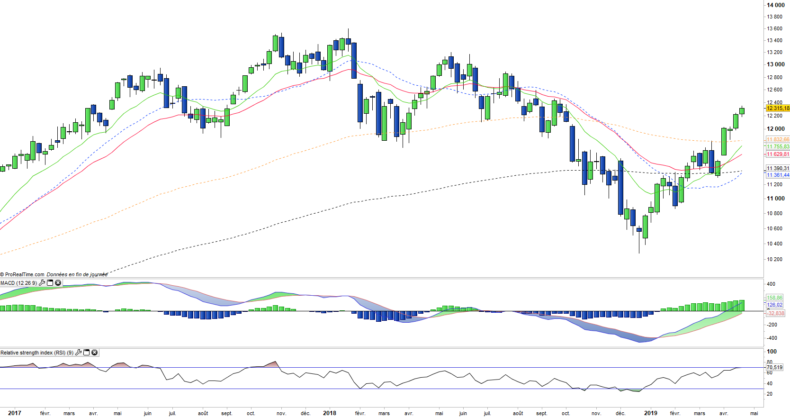DAX index - DAX - 27/04/19
Short Term trend: Positive (75/100)
Long Term trend: Positive (60/100)
(scores computed by our proprietary algorithms - cf methodology)
to access to our Buy / Sell signals
on ETFs and Stocks
Index profile
The top 10 stocks are mainly large industrial stocks such as Siemens or Bayer, while there are only 2 financial stocks in the DAX: Allianz and Munchener Rueck, the German master index is relatively small and mostly composed of large industrial groups.
Unlike the English, French or Italian indices, the DAX is also distinguished by the absence of large oil companies that weigh heavily in the weighting of the CAC40, FTSE100 or FTSEMIB40, which is double-edged according to the cycle specific to energy sector. In addition, the financials weigh only 16% of the index, half for the insurance giant Allianz, so the banking sector has a low weight reflected in the well-known weakness of Deutsche Bank and Commerzbank. Conversely, the automotive and chemical sectors are heavier than the other European indices, while the technology sector is mainly represented by SAP (11%) whose market capitalization exceeds € 110 billion.
In summary, the DAX is a fairly strong index from a sectoral point of view which can make it evolve differently from other European indices. German fundamentals are very solid (historically low unemployment rate at 5.5% and accelerated deleveraging up to 2020).
The main risks concern Germany's main customers, namely the United Kingdom, which could suffer from Brexit, the US in political uncertainty and threatening it with a trade war, Russia which remains a difficult and aggressive neighbor and China because of its commercial practices which also tend to limit access to its domestic market to Western industrialists, particularly in the automotive and technology sectors.
After an increase of 6.9% in 2016, the DAX30 grew by 12.5% in 2017, more than the stoxx600 (+ 10.6%). But the index fell by -18.5% in 2018, which is a much lower performance than the Stoxx600NR (-10.7%). The DAX is catching up since the beginning of the year and is now up 16.6%, compared to 17% for the Stoxx600 and 17.3% for the S & P500.
The underperformance at the beginning of the year can be explained by the large share of cyclical stocks (chemicals, cars, equipment goods) in the index and Germany's exposure to international trade endangered by the US protectionist attitude and fears about Chinese growth on which German companies are increasingly dependent.
The rebound of the Chinese economy and the resilience of the US economy, against the backdrop of an accommodative central bank policy, have allowed the DAX to catch up more rapidly in recent weeks.
Instruments: DBXD (DB-x Tracker in Euro), DAXEX (iShares in Euro), DAX (Lyxor in Euro)
Technical analysis
Weekly data analysis
The weekly chart shows the acceleration of the bullish momentum since the crossing of the MME13 and 26 and the passing of the MME100. In a few weeks the weakest index in Europe has managed to reverse the trend and is now in a positive dynamic coupled with technical indicators that all go green. No overheating visible for the moment on the oscillators, while the RSI just enters the overbought area.
Daily data analysis
On the daily chart, we can see that the short-term trend turned bullish in April, with bullish and steady momentum that allow for a quick return to the levels reached in 2018. There is, however, at the daily level, some overheating technical indicators that are all fairly overbought, which could give rise to a short-term correction in the near future.
Country breakdown
| Germany | 100% |
Sector Breakdown
| Materials | 18% |
| Consumer Discretionary | 16% |
| Financials | 16% |
| Information technology | 15% |
| Industrials | 12% |
| Health Care | 10% |
| Communication Services | 5% |
| Others | 8% |
Top Ten Holdings
| SAP | 11% |
| Allianz | 9% |
| Linde | 9% |
| Siemens | 8% |
| BASF | 7% |
| Bayer | 6% |
| Daimler | 5% |
| Deutsche Telekom | 5% |
| Adidas | 4% |
| Muenchener Rueckver | 3% |


